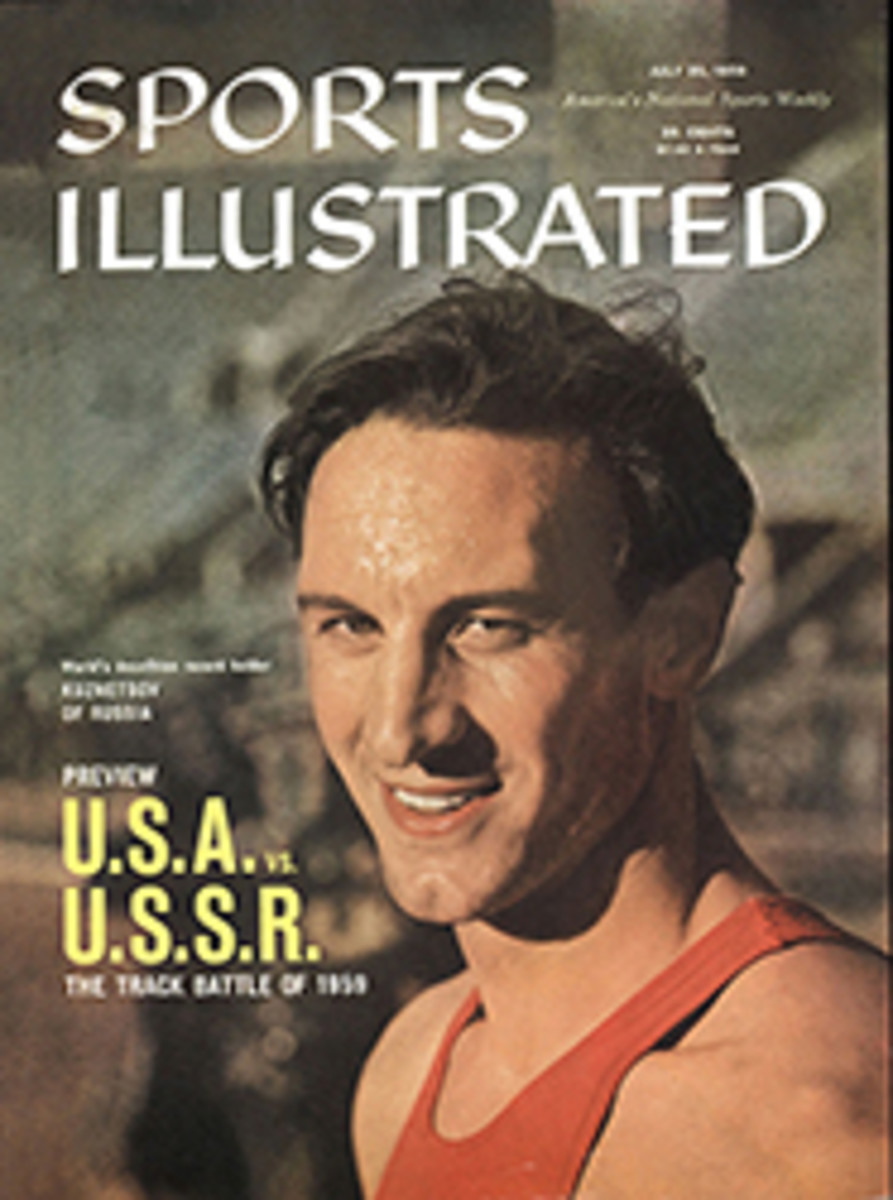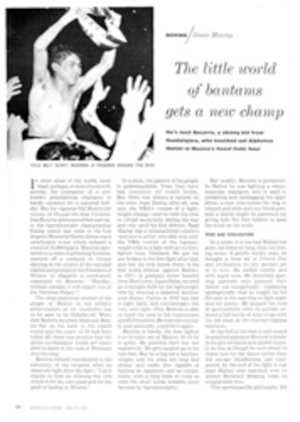
Mike shows how in the Western
Creeping quietly through Pittsburgh last week, almost buried under the clamor that seethed around a pending steel strike, the visit of Soviet First Deputy Premier Frol Kozlov, the All-Star baseball game and three frenetic extra-inning victories by the Pittsburgh Pirates, was the 56th Western Open golf championship, this country's second-oldest open tournament. It was won by Mike Souchak, currently the straightest long hitter in golf, who picked up a first prize of $5,000 with an 8-under-par 272 for 72 holes. Souchak has been on a strenuous diet that has pulled his weight down 25 pounds to a mobile 195 and, having won the Western, the Tournament of Champions, plus some $38,000 in cash, is in the midst of his finest competitive year.
This year's championship was played at the Pittsburgh Field Club, site of the 1937 PGA tournament, on a first-class course in prime condition and during perfect golfing weather. It was also played in almost complete seclusion, a condition that can be traced only to the fact that Pittsburgh is not much of a town for golf watching. There were only 1,400 spectators on hand the first two days. Scarcely 2,000 people on Saturday-saw the third round despite the fact that Arnold Palmer and Souchak, both local Pennsylvania boys, were the two leaders. Coming to the tee to start his third round Amateur Don Cherry, a crooner who can currently be heard rendering the Mr. Clean commercial, remarked: "This has got to be the most expensive private golf tournament ever put on."
On the final day a gallery of 3,000 watched Souchak pick up five strokes on Co-leader Palmer after 11 holes and tie him for the lead. On the 11th, a 504-yard par 5, Mike reached the green with a drive and a four-iron, getting his birdie while Palmer had to be content with a par. They played even to the 18th, an uphill par 3 of 220 yards where Souchak was on the green but 40 feet below the pin, while Palmer faded his drive into a trap some 15 feet to the right of the hole. Mike two-putted for a final round of 65, but Arnold, after exploding out only three feet away from the cup, missed the tricky sidehiller and Souchak had won the championship.
DWINDLING STATUS
At one time, in a history that dates back to 1899, the Western ranked second only to the National Open as a big-time, prestige golf event. It was an important playing date for all the ranking professionals and amateurs, and even Bob Jones, who seldom strayed far from the national championship reservation, competed in the 1921 installment. The list of Western winners contains golf's most evocative names, Willie Anderson, Chick Evans, Mac Smith, Walter Hagen (five times), Jim Barnes, Tommy Armour, Gene Sarazen, Ralph Guldahl (three successive wins), Byron Nelson, Jimmy Demaret, Ben Hogan, Sam Snead, Cary Middlecoff, Doug Ford and now Souchak. In the years since World War II, however, the Masters and PGA championships have moved well ahead as prestige events, and the Western now finds itself jumbled in with all the other weekly shows on the professional tour, scrambling desperately to keep its bones from getting picked absolutely clean of status. The chief factor behind this decline is the sudden flowering of so many rich, commercially backed tournaments that can afford to offer substantially more prize money than the Western Open's sponsors, these being various civic groups throughout the country which put on the Western in partnership with the Western Golf Association.
The WGA was founded in 1899 by a group of Chicago golf enthusiasts who chafed under what appeared to them to be the stealthy and unhealthy spread of eastern power in the guidance of national golf affairs. Today it is a contented subsidiary of the U.S. Golf Association, with 100 member clubs and 33,000 individual members. Its most vital function is that of running the Evans Scholars Foundation, a college scholarship program that is currently contributing liberally (an average of $625 per year per student) toward the college expenses of some 400 former caddies. The executive vice-president of the WGA is a crew-cut, gray-haired man of 47 named Milton Woodard, who directs the association's tournaments. While last week's tournament clipped along outside, Woodard sat in an office just off the Field Club's locker room.
"We're struggling, we're struggling," he admitted, chewing on a burned-out cigar. "It's hard to see what kind of shape the golf-tournament picture is taking. I know we're being hurt by the tremendous influx of commercial, big-money tournaments like the Chicago and Buick Opens. They were put on just before ours this year, and both of them are $50,000 deals compared to our $25,000. Moneywise we can't compete against them because our tournaments are backed by civic groups who can't get up that kind of cash. In fact, I doubt if any average tournament can make money on its own merits without a fantastic amount of advance selling and promotion by the club members and their committees. I'm just thinking out loud here, but it seems to me that the future of tournament golf depends now on what the commercial guy does."
Actually, though the Western Open may have lost some of its glamour in the eyes of the general golfing public which associates big events with big money, it still retains a high position among competing golfers.
"I've always ranked it among the top four," says Doug Ford, who won the event in 1957, has played in eight others and is decidedly averse to sentiment in such matters. "Just behind the Open, Masters and the PGA."
The Western's strength lies partly in the fact that it is almost always played on first-rate golf courses, but largely its standing comes from a long and glowing history. Originally the event was held entirely in the Midwest but, as the association expanded, the Western began to move around the country and in recent years has been lodged as far afield as Portland, Ore. and Buffalo.
Much of the Western's colorful tradition has been supplied by the flamboyant Walter Hagen, who won the title in 1916, 1921, 1926, 1927 and 1932. Hagen, now 66, was recently visited at his summer home in Traverse City, Mich. and asked to recall some of his Western triumphs.
"Hell, yes," was his response, the old sparkle coming into his bright green eyes, "we had a lot of fun in those days." He got two cans of beer out of the refrigerator and described how he beat Jock Hutchison in his first Western back in 1916 at Blue Mound Country Club in Milwaukee.
"I'd been playing the first nine holes in the final round in bad style," he went on. "In fact, I'd really balled them up when—and you have to get a kick out of this—I hit my tee shot to the front edge of the short ninth hole, about 40 feet from the hole. When I got down to the green, Jock, who was about to play up to the clubhouse from the 18th tee, looks over.
" 'How you doing?' he asked me.
" 'Lousy, how are you doing?'
" 'A three here for a 69.'
" 'Well, you've got it in the bag,' I told him, 'but wait a minute and watch this.' Then I stepped up and hit the ball, and it bumped and bumped and rolled right into the cup. After that I got a whole mess of threes and wound up beating Jock by one stroke."
Ten years later Hagen and Harry Cooper were putting on a nip-and-tuck fight for the championship.
"I'm playing just behind Cooper as we come to the 18th hole," Hagen continued. "He had a big gallery and I had my big gallery, but neither group knew what the other fellow was doing. I'm breaking the course record and so is he, but I'm ahead of him in the tournament. He's down the middle with his drive on 18 and then puts his second shot up about 10 feet below the cup. Then he knocks it in the cup and goes on into the clubhouse where everyone's congratulating him for breaking the course record and maybe winning the championship."
Hagen played an almost identical three to tie Cooper's minutes-old course record and stay ahead of him by several strokes with only 18 holes left to play. His young son, Walter Jr., had been walking along with him.
"I figured this would be a good place to have some fun with the boys," Hagen said, "so I put the kid up there on my shoulders, looking real nonchalant. When I got inside the locker room there's everyone around Cooper, making a big fuss."
" 'What's all the commotion?' I asked.
" 'Why Harry's just broken the course record with a 66 and looks like he's going to win.'
" 'Sixty-six only ties the record,' I said.
" 'No, no, it breaks it,' they all shouted.
" 'Sorry, boys, but I just shot a 66 too and I guess I'll win this thing after all.' "
Hagen then took a sip of beer, smiled in mischievous recollection and said to his visitor, "That was the most interesting finish as far as I'm concerned, but I wouldn't say it was too interesting for Harry. I beat him by seven strokes."
Another decade later, in 1936, Ralph Guldahl began his amazing streak by winning the first of three successive Western championships at Davenport, Iowa. In 1937 and 1938 he was also to win the U.S. Open.
"I remember that tournament well," says Charlie Bartlett, the Chicago Daily Tribune's able golf writer.
"Guldahl had absolutely no dough at all and was staying with his wife and little boy in some dollar-a-night hotel. Well, he won that tournament, then went to the Northwest and won out there and wound up one of the year's leading money winners. Boy, he was on his way then."
The years since Guldahl's three straight victories have also been filled with dramatic moments, of which Mike Souchak's victory is an important one, but its supporters can now only hope that the Western, like Guldahl, is still on its way rather than simply on its way out.
PHOTO
SOUCHAK BLASTS FROM ROUGH ON WAY TO ONE-SHOT VICTORY
PHOTO
EARLY JOY for Palmer turned to gloom on last hole where he missed three-foot putt.

